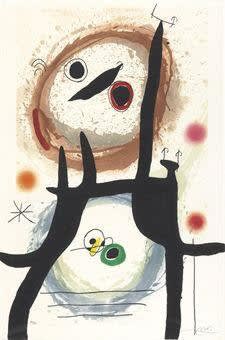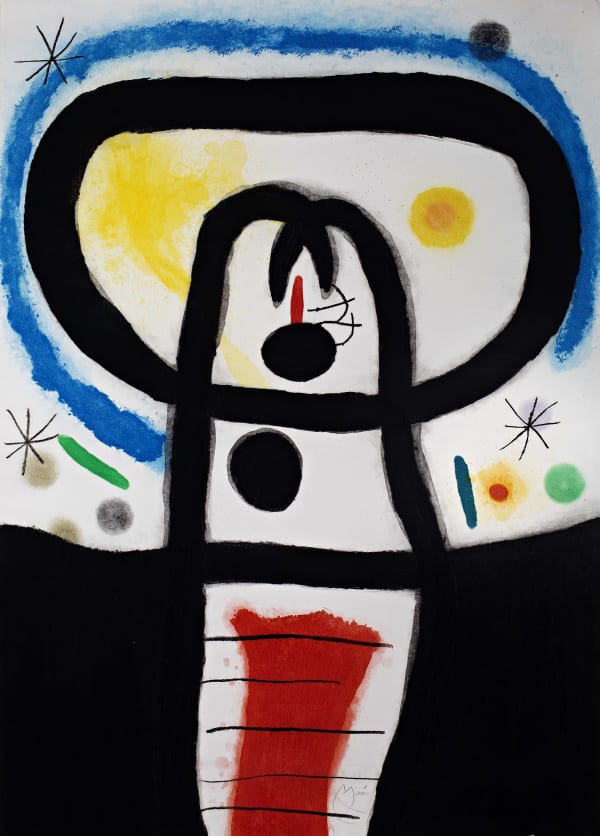A retrospective of the work of Joan Miro is opening next week at the Galeries Nationales of the Palais in Paris. Over 150 works, spanning Miro's 70-plus year career, will be on display. One of the most impressive works in the exhibit is The Farm, whose history is almost as interesting as the painting itself.
Joan Miro and Ernest Hemmingway
Joan Miro moved from his home Barcelona to Paris, in 1920, to be part of the cutting edge artistic movement that was taking place there. Around the same time, Ernest Hemmingway moved from the U.S. to Paris, working as a foreign correspondent for the Toronto Star. Miro and Hemmingway, both in their twenties, became friends. Miro was having difficulty selling his paintings and Hemmingway was piling up rejection slips from publishers. Miro would return from Paris each summer to his family's farm in the village of Montroig, and even took Hemmingway on a visit to the farm.
The Farm in Paris
In the nearly 100 years since the painting was completed in Paris, it has traveled thousands of miles and changed hands many times, before its return trip this year. Joan Miro painted the family farm from memory while living in Paris. The Farm combined surrealism, cubism and a strong sense of color which would be recognized as the seminal work that moved Miro to create the abstract style that became uniquely his own.
Hemmingway loved the painting of The Farm, but had little money and didn't think he could ever afford to buy it. In 1925, Miró finally had a show at the Galerie Pierre, and the dealer offered Hemingway's friend, poet and gambler, Evan Shipman, a chance to buy one of Miro's works.
Shipman chose The Farm, not knowing how much Hemmingway wanted it. According to Hemmingway, they shot dice for the painting and Hemmingway won. He had to take a job selling vegetables to come up with the 3,500 francs (about $175 at the time) before he could take the painting home.
Ernest Hemingway and his fourth wife, Mary, with Miró's painting of The Farm at their home near Havana in the 1940s. Hemmingway divorced his first wife, Hadley, and told her that she could have The Farm. Hadley and her second husband loaned The Farm to the Art Institute of Chicago in 1934. The painting was not returned to Hadley, but to Hemmingway and his second wife, Pauline, who were living in Key West.
In 1941, MoMA director, Albert Barr, asked Hemmingway to loan the painting to the museum for a Miro exhibit. By then, Hemmingway was married to his third wife, Martha, and the painting was at their home in Cuba. Hemmingway apologized to Barr, saying that the painting was in too poor a condition to ship.
In 1957, Hemmingway and his fourth wife, Mary, went to MoMA and offered The Farm to Barr. Barr wanted the painting for a major Miro exhibit scheduled for 1959. The catch was that the painting was in Cuba and Cuba was in the throes of a revolution. Also, the painting did not, technically, belong to Hemmingway, but still belonged to his first wife, Hadley. But Barr did not know that.
Hemmingway and Mary had left Cuba and settled in Ketchum, Idaho. Hemmingway said that if MoMA wanted the painting, MoMA would have to figure out how to get it. MoMA curator, Jim Soby, and assistant registrar , David Vance, devised a plan to get the painting out of revolutionary Cuba. They had to wait until after the collapse of the Batista Regime and the coming to power of Fidel Castro. During the first week of February, 1959, Vance managed to fly in to Cuba, get the painting and bring it back to New York.
When MoMA staff got their first look at The Farm, they were shocked. The painting had spent years in a house with ceiling leaks and no air conditioning, on a damp, tropical island.
Joan Miró and curator James Soby at MoMA, 1959
Hemmingway blamed MoMA for the state of the painting, but told Barr to go ahead and restore it. The painting was restored and was still hanging in MoMA when, in 1961, Hemmingway committed suicide. Mary asked MoMA to return The Farm to her, but first wife, Hadley, said that The Farm belonged to her. A settlement was reached, and Mary got the painting, which she donated to the National Gallery of Art in Washington, D.C. in 1976. It is currently in Paris for the duration of the Miro exhibit, which runs through February, 2019. Then it will return home, to the National Gallery.
Works by Joan Miro at the Surovek Gallery
Please contact us if you would like more information about the works of Joan Miro available at the Surovek Gallery.
References:
https://www.nga.gov/collection/art-object-page.69660.html
en.vogue.fr/fashion-culture/fashion-exhibitions/story/grand-palais-exhibition-michael-jackson-joan-miro-venice-fall/3685″>https://en.vogue.fr/fashion-culture/fashion-exhibitions/story/grand-palais-exhibition-michael-jackson-joan-miro-venice-fall/3685
www.vanityfair.com/style/2018/09/ernest-hemingway-joan-miro-the-farm-painting
September 26th, 2018



